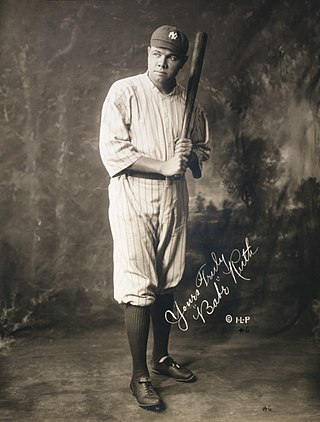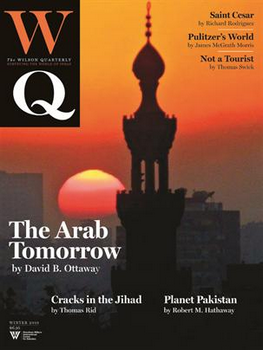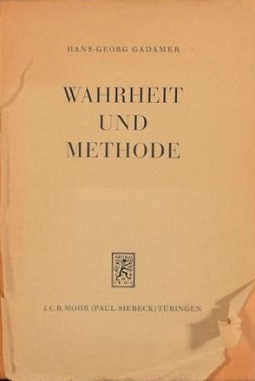
George Herman "Babe" Ruth was an American professional baseball player whose career in Major League Baseball (MLB) spanned 22 seasons, from 1914 through 1935. Nicknamed "the Bambino" and "the Sultan of Swat", he began his MLB career as a star left-handed pitcher for the Boston Red Sox, but achieved his greatest fame as a slugging outfielder for the New York Yankees. Ruth is regarded as one of the greatest sports heroes in American culture and is considered by many to be the greatest baseball player of all time. In 1936, Ruth was elected into the Baseball Hall of Fame as one of its "first five" inaugural members.

Cultural anthropology is a branch of anthropology focused on the study of cultural variation among humans. It is in contrast to social anthropology, which perceives cultural variation as a subset of a posited anthropological constant. The term sociocultural anthropology includes both cultural and social anthropology traditions.

Reader-response criticism is a school of literary theory that focuses on the reader and their experience of a literary work, in contrast to other schools and theories that focus attention primarily on the author or the content and form of the work.
New Criticism was a formalist movement in literary theory that dominated American literary criticism in the middle decades of the 20th century. It emphasized close reading, particularly of poetry, to discover how a work of literature functioned as a self-contained, self-referential aesthetic object. The movement derived its name from John Crowe Ransom's 1941 book The New Criticism.
"The Death of the Author" is a 1967 essay by the French literary critic and theorist Roland Barthes (1915–1980). Barthes's essay argues against traditional literary criticism's practice of relying on the intentions and biography of an author to definitively explain the "ultimate meaning" of a text. Instead, the essay emphasizes the primacy of each individual reader's interpretation of the work over any "definitive" meaning intended by the author, a process in which subtle or unnoticed characteristics may be drawn out for new insight. The essay's first English-language publication was in the American journal Aspen, no. 5–6 in 1967; the French debut was in the magazine Manteia, no. 5 (1968). The essay later appeared in an anthology of Barthes's essays, Image-Music-Text (1977), a book that also included his "From Work to Text".

Konstantin Georgiyevich Paustovsky was a Soviet writer nominated for the Nobel Prize for literature in 1965.
Babe Ruth's called shot is the home run hit by Babe Ruth of the New York Yankees against the Chicago Cubs in the fifth inning of Game 3 of the 1932 World Series, held on October 1, 1932, at Wrigley Field in Chicago. During the at-bat, Ruth made a pointing gesture which the existing film confirms, but whether he was promising a home run, or gesturing at fans or the Cubs in their dugout, remains in dispute.

Big History is an academic discipline which examines history from the Big Bang to the present. Big History resists specialization, and searches for universal patterns or trends. It examines long time frames using a multidisciplinary approach based on combining numerous disciplines from science and the humanities, and explores human existence in the context of this bigger picture. It integrates studies of the cosmos, Earth, life, and humanity using empirical evidence to explore cause-and-effect relations, and is taught at universities and primary and secondary schools often using web-based interactive presentations.

Mosquitoes is a satiric novel by the American author William Faulkner. The book was first published in 1927 by the New York-based publishing house Boni & Liveright and is the author's second novel. Sources conflict regarding whether Faulkner wrote Mosquitoes during his time living in Paris, beginning in 1925 or in Pascagoula, Mississippi in the summer of 1926. It is, however, widely agreed upon that not only its setting, but also its content clearly reference Faulkner's personal involvement in the New Orleans creative community where he spent time before moving to France.

A Preface to Paradise Lost is one of C. S. Lewis's most famous scholarly works. The book had its genesis in Lewis's Ballard Matthews Lectures, which he delivered at the University College of North Wales in 1941. It discusses the epic poem Paradise Lost, by John Milton.
William Eugene Bryson Sr. was an American sportswriter who wrote for The Des Moines Register from 1937 until his retirement in 1978. He covered 32 consecutive World Series.
Law, Legislation and Liberty (1973–1979) is a work in three volumes by Nobel laureate economist and political philosopher Friedrich Hayek.
The 1927 New York Yankees season was the 25th season of the New York Yankees of the American League. The team finished with a record of 110–44–1, winning their fifth pennant and finishing 19 games ahead of the Philadelphia Athletics and were tied for first or better for the whole season. New York was managed by Miller Huggins, and played at Yankee Stadium. They won the 1927 World Series, sweeping the Pittsburgh Pirates. This Yankees team was known for its feared lineup, which was nicknamed "Murderers' Row", and is widely considered to be the greatest baseball team in MLB history.

The Wilson Quarterly is a magazine published by the Woodrow Wilson International Center for Scholars in Washington, D.C. The magazine was founded in 1976 by Peter Braestrup and James H. Billington. It is noted for its nonpartisan, non-ideological approach to current issues, with articles written from various perspectives. From Summer 2012 it has been published online.

Truth and Method is a 1960 book by the philosopher Hans-Georg Gadamer, in which the author deploys the concept of "philosophical hermeneutics" as it is worked out in Martin Heidegger's Being and Time (1927). The book is considered Gadamer's major work.
Color analysis, also known as personal color analysis (PCA), seasonal color analysis, or skin-tone matching, is a term often used within the cosmetics and fashion industry to describe a method of determining the colors of clothing, makeup, hair style that harmonizes with a person's skin complexion, eye color, and hair color for use in wardrobe planning and style consulting. It is generally agreed that the wrong colors will draw attention to such flaws as wrinkles or uneven skin tone while harmonious colors will enhance the natural beauty of the individual making them appear healthy, brighter, and possible more attractive or put-together.

At Home: A Short History of Private Life is a history of domestic life written by Bill Bryson. It was published in May 2010. The book covers topics of the commerce, architecture, technology and geography that have shaped homes into what they are today, told through a series of "tours" through Bryson's Norfolk rectory that quickly digress into the history of each particular room.
I Remain Alive: the Sioux Literary Renaissance is a scholarly book written by Ruth J. Heflin and published by Syracuse University Press in 2000.
Childbirth and Authoritative Knowledge: Cross-Cultural Perspectives is a collection of anthropological essays that study birth and authoritative knowledge across sixteen different cultures that was first published in 1998 in the Journal of Gender Studies. It "extends and enriches" anthropologist Brigitte Jordan's work in the anthropology of birth. In 2003, it won the Council on Anthropology and Reproduction book award.

The second circle of hell is depicted in Dante Alighieri's 14th-century poem Inferno, the first part of the Divine Comedy. Inferno tells the story of Dante's journey through a vision of the Christian hell ordered into nine circles corresponding to classifications of sin; the second circle represents the sin of lust, where the lustful are punished by being buffeted within an endless tempest.











